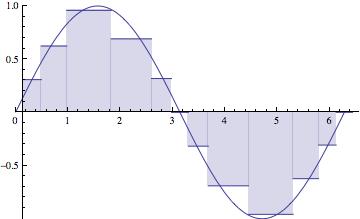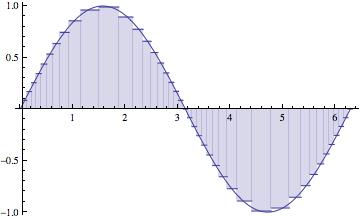- Reminder: turn off your rectangles.
- Your first assignment is due today
- This section generalizes our intuition and examples from the preceding section.
- There's a lot of notation. Try not to let that intimidate you. A lot of Greek letters. A lot of indices, like i. There are parameters floating around, like n.
- Last time we got to a point at which we had a thing, called a "Riemann
sum", based on the following stuff:
- a function
;
- an interval [a,b] over which to calculate the area;
- a "partition" P of the interval into N subintervals, with "endpoints"
and widths
;
i is a variable (an index) that runs from 1 to N. It indicates the particular subinterval (the ith subinterval) under consideration.
So the endpoints of the ith subinterval are
on the left, and
on the right.
- A set C of "Centers"
of the subintervals, at which we calculate the function values
"Centers" might be a poor choice of words, since the centers may not be at all in the centers of the subintervals.

where P is a partition of the interval [a,b]:
and where C is a set of centers,
such that each center falls in one subinterval, where i runs from 1 to N:
Last time we saw that a rectangle method dictates a choice of "centers" for the Riemann sum:
- LRR:
- RRR:
- MID:
(this one really is in the center of the subinterval -- that's the average of the two endpoints).
- a function
- If the size of the intervals goes to zero, then the
approximations get better and better, until they're perfect!

where
 |
 |
 |
| The maximum subinterval width ( |
||
If it's continuous except for a finite number of jump discontinuities, it's still integrable.
So lots of important functions are integrable.




Again, we can use this relationship to define the average value of a function on the interval [a,b]
- Linear and quadratic functions
- #10, p. 307
- #33
- #21